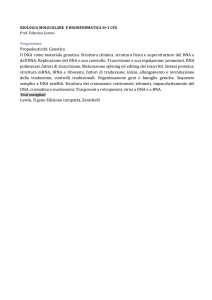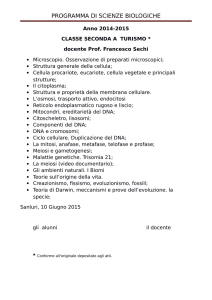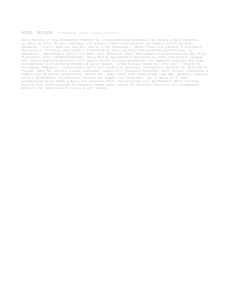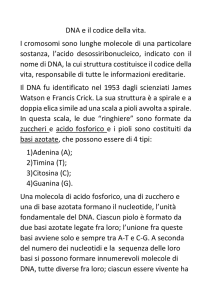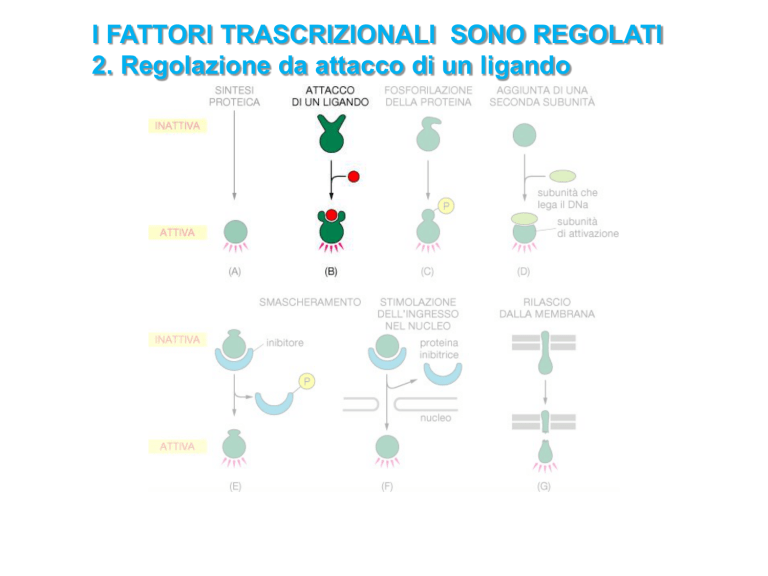
I FATTORI TRASCRIZIONALI SONO REGOLATI
2. Regolazione da attacco di un ligando
THE NUCLEAR RECEPTORs SUPERFAMILY
RECETTORI (si attivano in risposta a segnali)
FATTORI TRACRIZIONALI (regolano l’espressione di geni
interagendo direttamente con
il DNA)
THE NUCLEAR RECEPTORs SUPERFAMILY
PROTEINE SOLUBILI CHE LEGANO ELEMENTI REGOLATORI
SPECIFICI SUL DNA (RESPONSE ELEMENTS RE)
ATTIVATI DAL LEGAME CON LIGANDI SPECIFICI, PICCOLE
MOLECOLE LIPOFILE CHE ATTRAVERSANO LE MEMBRANE
BIOLOGICHE
CLASSIFICATI IN BASE AL MECCANISMO D’AZIONE (TIPO I O II)
OPPURE IN BASE ALL’OMOLOGIA DI SEQUENZA (NR subfamily 06)
PIU’ DI 300 STRUTTURE NOTE DI CUI 48 NELL’UOMO
PER LA GRAN PARTE DEI NRs IDENTIFICATI NON E’ NOTO IL
LIGANDO (RECETTORI ORFANI, NELL’UOMO 24)
HUMAN NUCLEAR RECEPTORs CLASSIFICATION
1. Hormone passes
through plasma
membrane
Blood
plasma
Lipophilic hormones
Plasma membrane
Cytoplasm
Nucleus
Receptor
2. Inside target
cell the hormone
binds to a
receptor protein
in the cytoplasm
or nucleus
3. Hormone-receptor
complex binds to
hormone response
element on DNA,
regulating gene
transcription
5. Change in protein
synthesis is
cellular response
mRNA
Protein
DNA
4. Protein synthesis
Hormone response element
THE NUCLEAR RECEPTOR LIGANDS
Molecole lipofile come ormoni, vitamina A e D, farmaci, Xenobiotici
distruttori endocrini:
NUCLEAR RECEPTORS STRUCTURAL ORGANIZATION
NUCLEAR RECEPTORS DNA BINDING DOMAIN (DBD)
NUCLEAR RECEPTORS LIGAND BINDING DOMAIN (LBD)
Il modello a trappola del legame
I RECETTORI NUCLEARI POSSONO ESSERE CLASSIFICATI IN
4 TIPI SULLA BASE DELLE LORO PROPRIETA’ DI LEGAME AL DNA
AL LIGANDO E MODALITA’ DI DIMERIZZAZIONE
MECCANISMO D’AZIONE DEI NRs DI TIPO I
Mechanism nuclear receptor action. This figure depicts the mechanism of a class I nuclear
receptor (NR) which, in the absence of ligand, is located in the cytosol. Hormone binding
triggers dissociation of heat shock proteins (HSP), dimerization, and translocation to the
nucleus where it binds to a specific sequence of DNA known as a hormone response element
(HRE). The nuclear receptor DNA complex in turn recruits other proteins that are responsible
for translation of downstream DNA into RNA and eventually protein which results in a change
in cell function
MECCANISMO D’AZIONE DEI NRs DI TIPO II
This figure depicts the mechanism of a class II nuclear receptor (NR) which, regardless of ligand binding
status is located in the nucleus bound to DNA. For the purpose of illustration, the nuclear receptor
shown here is the thyroid hormone receptor (TR) heterodimerized to the RXR. In the absence of ligand,
the TR is bound to corepressor protein. Ligand binding to TR causes a dissociation of corepressor and
recruitment of coactivator protein which in turn recruit additional proteins such as RNA polymerase that
are responsible for transcription of downstream DNA into RNA and eventually protein which results in a
change in cell function.
Complessi di coattivatori (in verde) e corepressori (in rosso) richiesti per la regolazione
trascrizionale mediata dai recettori nucleari. Queste proteine possono avere esse stesse un’attività di
istone acetiltrasferasi o deacetilasi oppure, in alternativa, possono legare proteine con questa funzione
(Perissi and Rosenfeld, 2005).
Nuclear hormone receptors (48 diverse proteine)
Classici
Adottati
Orfani
GR (Glucocorticoidi)
ER (Estrogeni)
AR (Androgeni)
TR (Ormone tiroideo)
VDR (Vit D)
RAR, RxR, (Acido retinoico)
…
FXR
(Farnesoidi) LxR
PPAR a/g/d
PXR (pregnano)
…
???
Acidi biliari
ossisteroli
Acidi grassi
xenobiotici
…
Componenti della dieta come ligandi dei NHR
Cafestol
FXR, PXR
Curcumin
VDR
Flanoidi (soia, uva, vino rosso, ecc.) LXR, FXR, PPAR
Fitosteroli
Probiotici
LXR, FXR, PPAR
???
KEY CONCEPTS OF THE WEEK 2
I FATTORI TRASCTIZOIONALI CHE REGOLANO LA TRASCRIZIONE
SONO A LORO VOLTA REGOLATI
perché?
SONO REGOLATI ATTRA VERSO VARI MECCANISMI QUALI?
I MECCANISMI SONO DIVERSI PERCHE’ SONO FUNZIONALI A SCOPI
DIVERSi
QUALI?

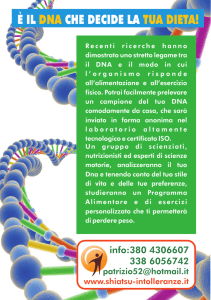
![mutazioni genetiche [al DNA] effetti evolutivi [fetali] effetti tardivi](http://s1.studylibit.com/store/data/004205334_1-d8ada56ee9f5184276979f04a9a248a9-300x300.png)
![ESTRAZIONE DNA DI BANANA [modalità compatibilità]](http://s1.studylibit.com/store/data/004790261_1-44f24ac2746d75210371d06017fe0828-300x300.png)
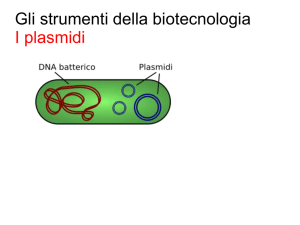
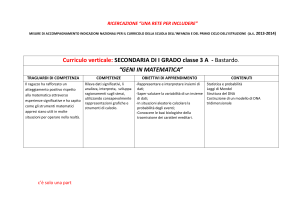
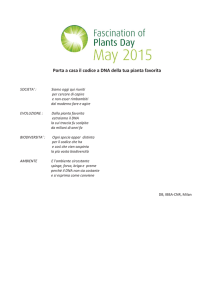
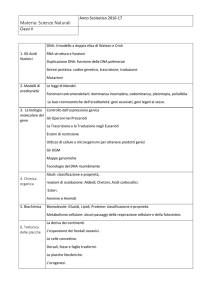
![(Microsoft PowerPoint - PCR.ppt [modalit\340 compatibilit\340])](http://s1.studylibit.com/store/data/001402582_1-53c8daabdc15032b8943ee23f0a14a13-300x300.png)
